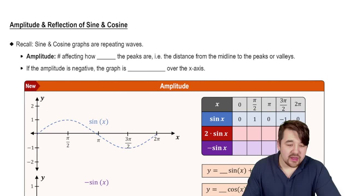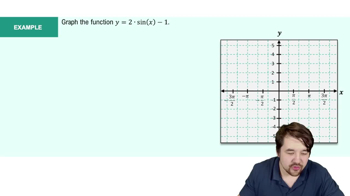Table of contents
- 0. Review of College Algebra4h 43m
- 1. Measuring Angles39m
- 2. Trigonometric Functions on Right Triangles2h 5m
- 3. Unit Circle1h 19m
- 4. Graphing Trigonometric Functions1h 19m
- 5. Inverse Trigonometric Functions and Basic Trigonometric Equations1h 41m
- 6. Trigonometric Identities and More Equations2h 34m
- 7. Non-Right Triangles1h 38m
- 8. Vectors2h 25m
- 9. Polar Equations2h 5m
- 10. Parametric Equations1h 6m
- 11. Graphing Complex Numbers1h 7m
4. Graphing Trigonometric Functions
Graphs of the Sine and Cosine Functions
Problem 4.35b
Textbook Question
Graph each function over a two-period interval. Give the period and amplitude. See Examples 2–5.
y = -2 sin 2 πx
 Verified step by step guidance
Verified step by step guidance1
Identify the standard form of the sine function, which is \( y = a \sin(bx + c) + d \). In this case, \( y = -2 \sin(2\pi x) \).
Determine the amplitude of the function. The amplitude is the absolute value of the coefficient \( a \). Here, \( a = -2 \), so the amplitude is \(|-2| = 2\).
Find the period of the function. The period of a sine function is given by \( \frac{2\pi}{b} \), where \( b \) is the coefficient of \( x \). In this case, \( b = 2\pi \), so the period is \( \frac{2\pi}{2\pi} = 1 \).
Graph the function over a two-period interval. Since the period is 1, a two-period interval would be from \( x = 0 \) to \( x = 2 \).
Plot key points of the sine function within the interval, considering the amplitude and period. The key points for one period of \( y = \sin(x) \) are at \( x = 0, \frac{1}{4}, \frac{1}{2}, \frac{3}{4}, 1 \). Adjust these points for the given function \( y = -2 \sin(2\pi x) \).
Recommended similar problem, with video answer:
 Verified Solution
Verified SolutionThis video solution was recommended by our tutors as helpful for the problem above
Video duration:
0m:0sPlay a video:
Was this helpful?
Key Concepts
Here are the essential concepts you must grasp in order to answer the question correctly.
Period of a Trigonometric Function
The period of a trigonometric function is the length of one complete cycle of the wave. For the sine function, the standard period is 2π. However, when the function is modified, such as in y = -2 sin(2πx), the period can be calculated by dividing the standard period by the coefficient of x, which in this case is 2π, resulting in a period of 1.
Recommended video:

Period of Sine and Cosine Functions
Amplitude of a Trigonometric Function
The amplitude of a trigonometric function refers to the maximum distance the function reaches from its midline. In the function y = -2 sin(2πx), the amplitude is given by the absolute value of the coefficient in front of the sine function, which is 2. This means the graph will oscillate between -2 and 2, but since the sine function is negated, it will reflect the wave vertically.
Recommended video:

Introduction to Trigonometric Functions
Graphing Sine Functions
Graphing sine functions involves plotting the values of the function over a specified interval. For y = -2 sin(2πx), the graph will show a wave that oscillates between -2 and 0, with a period of 1. Understanding how to identify key points, such as the maximum, minimum, and intercepts, is essential for accurately representing the function over the given interval.
Recommended video:

Graph of Sine and Cosine Function

 5:53m
5:53mWatch next
Master Graph of Sine and Cosine Function with a bite sized video explanation from Nick Kaneko
Start learningRelated Videos
Related Practice
















